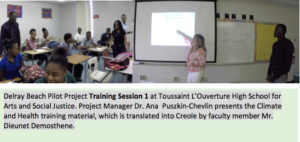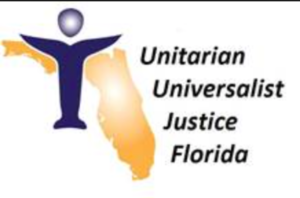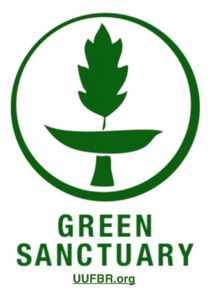Timeline: Weeks 13 – 16
Community Training Sessions for People within the Community who will be Doing Outreach
Assure that all materials are copied and stapled and put in order for the training session. They should be given to the Outreach Leaders to distribute to their team of Communicators.
Training Session 1
The numbers below are for a training session of 20 people, who will survey and educate 100 residents.
- Each participant has a two-pocket folder containing: an Outreach Report, 5 Sea Level Rise Risk (SLR) Perception Surveys, 5 laminated Climate and Health 2-sided fact sheets, and one 12-page Climate and Health Toolkit of detailed fact sheets. All printed materials will be template modifications with names of the funders and local partners, when they will fit on the pages. Local emergency numbers and maps will be substituted into all templates.
- All participants remove the Outreach Report from their two-pocket folder, and place their address on the first line.
- All participants take one SLR Risk Perception Survey from their two-pocket folder, and respond to the questions. They then check off the SLR survey on their Outreach Report to indicate that the first person on their Outreach Report (themselves) has taken the Survey.
- All participants take one Climate and Health 2-sided Information Sheet out of their two-pocket folder, and participate in the training. A facilitator shows the Climate and Health Powerpoint, stopping after each topic to allow participants to practice explaining the material to each other. They then check off the Education to indicate that the first person on their Outreach Report (themselves) has taken the Survey.
- All participants sign up for Code Red, and check it off on their Outreach Form.
- All participants enter the language(s) spoken in their household and the best way to reach them about the community meeting in their Outreach Form.
- Participants take out the 12 page Climate and Health Toolkit of detailed fact sheets and are told that it is for their reference if they have forgotten something or need more detail.
- All participants are given 5 magnets to distribute to people in the community when the give them the laminated Climate and Health 2-sided fact sheet.
- Next Steps: Create a tabling or canvassing protocol for organizations that will be doing tabling at events. Groups that will be doing neighborhood surveys will need training and mentorship on safety and protocol.
If you have 10 members on your Outreach Team, each will receive 2 Outreach forms, 10 SLR Surveys, 10 laminated Climate and Health Outreach forms and 10 Magnets. Each Outreach Team member will only need one 12-page Climate and Health Toolkit of detailed fact sheets.

This website is maintained by the Unitarian Universalist Justice Florida’s Climate Resilience Ministry. It was established by the Green Sanctuary Committee of the Unitarian Universalist Fellowship of Boca Raton. The community pilot projects, on which the Community Toolkit was based, were undertaken in partnership with Developing Interracial Social Change (DISC) and Habitat for Humanity in Boca Raton, Florida; and Toussaint L’Ouverture High School for Arts and Social Justice in Delray Beach, Florida. Project Director for that effort was Janice T. Booher, MS. Pilot Project Manager Phase I was Dr. Ana Puszkin-Chevlin. Pilot Project Manager Phase II was Debra Weiss-Randall, Ed. D, CHES.
- This project is funded in part by the Unitarian Universalist Fund for Social Responsibility.
- Funding for this project was provided by the Unitarian Universalist Fellowship of Boca Raton Endowment Fund.
- Funding for the project in Shorecrest, Miami with the Community Health Mapping Initiative is provided by the National Library of Medicine/NIH.
- Development of the ReACT Tool Kit and the Pilot Projects were funded by EPA Environmental Justice Grant #EQ-00D35415-0 awarded to the Green Sanctuary Committee of the Unitarian Universalist Fellowship of Boca Raton.
Website designed and maintained by Janice T. Booher


